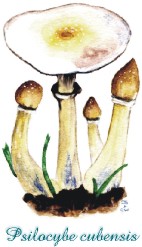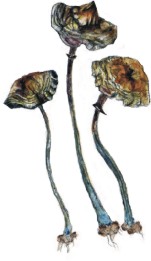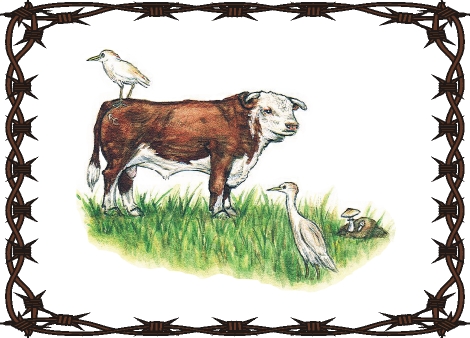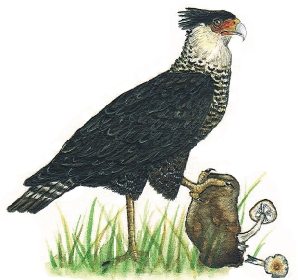Discovered by F.S. Earle in Cuba in 1904 (as Stropharia cubensis), this species is the largest and, arguably, the most handsome of all the Psilocybes. Where other Psilocybes are just plain folk, cubensis is gentry. In 1907 it was collected in Tonkin (now N. Vietnam) by N. Patouillard, and again in 1939 near Huautla de Jimenez, Oaxaca, Mexico, by acclaimed Harvard botanist and explorer Richard Evans Schultes, who described it in the Harvard University Botanical Museum Leaflets, and deposited specimens in the Farlow Herbarium at Harvard. Schultes was aided by Dr. Blas Pablo Reko, a Mexican naturalist who was one of the first to unravel the mystery surrounding the Indians' use of the divine mushrooms.
Unaware of these previous citings, W.A. Murrill described it in 1941 as the Florida novelty, Stropharia cyanescens. It is also one of the most widespread psychoactive species in the subtropics, ranging from the U.S. Gulf Coast, where it fruits virtually year-round on cow pies, to Mexico, Central America, South America, West Indies, Thailand, Cambodia, India and Australia.
Above: "San Isidro."
Aquarelle by Carol Ann Wells (depicting dried specimens). Courtesy The Stain Blue Museum Collection.
Known to the Indians of Mexico as "San Isidro," this species is extremely active, with dried specimens typically yielding over 1% combined psilocybin/psilocin content. N,N-dimethyltryptamine (DMT), a psychedelic compound that is inactive orally, is an intermediary metabolite present in the biosynthetic pathway of Psilocybe cubensis, being only one step away from psilocin and two from psilocybin. Psilocin (designated 4-hydroxy-N,N-dimethyltryptamine) and the human neurotransmitter serotonin (designated 5-hydroxytryptamine) differ by only one hydroxy molecule. In this respect, the mushrooms are mirror images of the human brain.
Above: Psilocybe cubensis, Texan strain.
Aquarelle by Carol Ann Wells (depicting dried specimens). Courtesy The Stain Blue Museum Collection.
Strains of Psilocybe cubensis are easily domesticated and will aggressively and potently fruit over a wide range of environmental parameters. Thanks to the Cattle Egret (Bubulcus ibis), a colonizer of Old World origin (via S. America), spores of this mushroom are carried for vast distances, thereby infecting virgin pastures. The Cattle Egret first appeared in Texas in 1955 and is now an abundant resident of Gulf Coast pastures, as is Psilocybe cubensis. The relationship between cattle, cattle egrets, and Psilocybe cubensis is an example of symbiosis -- a situation in which
dissimilar organisms live together in close association. Cattle egrets are fond of hitching rides on the backs of cows where they make easy prey of swarming insects [Smith 1996].
Above: "Symbiosis." Cattle and cattle egrets are vectors of Psilocybe cubensis spores.
Aquarelle by Carol Ann Wells. Courtesy The Stain Blue Museum Collection.
The Crested Caracara is another bird that frequents the pasturelands of Texas and Mexico. Also known as "Audubon's Caracara" or "Mexican Eagle," this raptor is often seen
feeding at cattle carcasses, in company with vultures. When carrion is scarce, the Crested Caracara may spend hours turning over cow pies in search of large beetles and other insects. Like the Cattle Egret, this bird is a potential vector of Psilocybe cubensis spores [Smith 1996].
Above: Crested Caracara (Caracara cheriway). Also known as "Mexican Eagle,"
this raptor is depicted on the Mexican flag and is believed to be an omen of good luck.
Aquarelle by Carol Ann Wells. Courtesy The Stain Blue Museum Collection.
Above: Psilocybe cubensis postage stamps from Argentina.
Courtesy of Jorge Alberto Vilas and The Stain Blue Museum Collection.
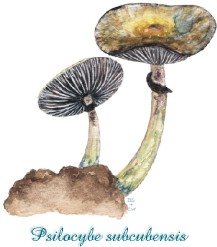
Psilocybe subcubensis, the pantropical sister species of Psilocybe cubensis, was first described by Dr. Gaston Guzman. It is macroscopically identical to Psilocybe cubensis, differing only by its smaller spores and consistently smaller pleurocystidia. It replaces Psilocybe cubensis throughout much of its tropical range and has recently been reported from Australia, India, and Thailand.
Above: Laboratory culture of Psilocybe subcubensis.
Below: Psilocybe subcubensis, harvested.
Photos courtesy EntheoGenesis Laboratories, SA.
Required Reading
Badham, E.R. "Ethnobotany of psilocybin [sic] mushrooms, especially Psilocybe cubensis." Journal of Ethnopharmacology 10(2): 249-254 (1984).
Bigwood, J. and M.W. Beug. "Variation of psilocybin and psilocin levels in repeated flushes (harvests) of mature sporocarps of Psilocybe cubensis (Earle) Singer." Journal of Ethnopharmacology 5(3): 287-291 (1982).
Catalfomo, P. and V.E. Tyler, Jr. "The Production of Psilocybin in Submerged Culture by Psilocybe cubensis." (Abstracted in part from a dissertation submitted to the Graduate School of the University of Washington by Philip Catalfomo in partial fulfillment of the requirements for the degree of Doctor of Philosophy.) Lloydia 27(1): 52-63 (1964).
Earle, F.S. "Algunos Hongos Cubanos." Informe anual. Estacion central agronomica de Cuba 1: 225-242 (1906).
Gartz, J. "Biotransformation of tryptamine derivatives in mycelial cultures of Psilocybe." Journal of Basic Microbiology 29(6): 347-352 (1989).
Gartz, J. "Biotransformation of tryptamine in fruiting mycelia of Psilocybe cubensis." Planta Medica 55(3): 249-250 (1989).
Gartz, J. et al. "Growth-promoting effect of a brassinosteroid in mycelial cultures of the fungus Psilocybe cubensis." Die NaturwiBenschaften 77: 388-389 (1990).
Guzman, G. The Genus Psilocybe: A Systematic Revision of the Known Species Including the History, Distribution and Chemistry of the Hallucinogenic Species. Beihefte zur Nova Hedwigia Heft 74. J. Cramer, Vaduz, Germany (1983).
Guzman, G. "Wasson and the development of mycology in Mexico." In: Riedlinger, T.J. (Ed.) The Sacred Mushroom Seeker: Essays for R. Gordon Wasson. Ethnomycological Studies No. 11, pp. 83-110. Dioscorides Press, Portland, OR (1990).
Heim, R. and A. Hofmann. "Isolement de la psilocybine a partir du Stropharia cubensis Earle et d'autres especes de champignons hallucinogenes mexicains appartenant au genre Psilocybe." Comptes Rendus Hebdomadaires des Seances de l'Academie des Sciences 247: 557-561 (1958).
Murrill, W.A. "Some Florida Novelties." Mycologia 33: 279 (1941).
Neal, J.M. et al. "Interrelationship of Phosphate Nutrition, Nitrogen Metabolism, and Accumulation of Key Secondary Metabolites in Saprophytic Cultures of Psilocybe cubensis, Psilocybe cyanescens, and Panaeolus campanulatus." (Abstracted in part from a thesis submitted by John M. Neal to the Graduate School, University of Washington, Seattle, in partial fulfillment of Master of Science degree requirements.) Journal of Pharmaceutical Sciences 57(10): 1661-1667 (1968).
Ott, J. Pharmacotheon. Natural Products Co., Kennewick, WA (1996).
Patouillard, N. "Champignons nouveaux de Tonkin." Bulletin de la Societe mycologique de France. 23: 69-79 (1907).
Pollock, S.H. "The psilocybin [sic] mushroom pandemic." Journal of Psychedelic Drugs 7(1): 73-84 (1975).
Repke, D.B. et al. "Baeocystin in Psilocybe, Conocybe, and Panaeolus." Lloydia 40(6): 566-578 (1977).
Schultes, R.E. "Planta Mexicanae II. The identification of teonanacatl, a Basidiomycete of the Aztecs." Botanical Museum Leaflets 7(3): 37-54. Harvard University (1939).
Smith, D. "The cattle egret (Bubulcus ibis): colonizer of Old World origin and a vector of Psilocybe cubensis spores." (Self-published.) Stain Blue Press, Spring, TX (1996).
Copyright © 1996-2000 Stain Blue Press
